
Communication before almond bloom leads to effective pollination
The first step toward a successful pollination season is communication between the beekeeper and grower-owner to ensure expectations are fully understood. Growers should contact beekeepers as early as possible before the pollination season to discuss their requirements.
September 2, 2014

The first step toward a successful pollination season is communication between the beekeeper and grower-owner to ensure expectations are fully understood.
Growers should contact beekeepers as early as possible before the pollination season to discuss their requirements.
Growers who do not have an established relationship with a beekeeper can refer to the Pollination Directory on the Almond Board of California website. This database includes beekeepers and bee brokers.
Growers and their beekeepers should outline and mutually agree on expectations of each other to avoid misunderstandings. Communication on pesticide use during bloom, for instance, should be a fundamental consideration.
This could mean outlining a pesticide plan that specifies which pest control materials might be used. The grower and beekeeper should agree on which products can be applied if a treatment is deemed necessary.
During bloom when applications are imminent, establish a line of communication throughout the chain of all parties involved in pollinating almonds and-or applying pesticides to orchards so they are informed ahead of time.
Growers may want beekeepers to register with the appropriate county agricultural commissioner. By registering with the commissioner and providing the location of colonies, beekeepers can request an advance notice of applications of pesticides labeled as toxic to bees within a mile of the colonies.
Grower-beekeeper responsibilities
Beyond pesticides, other elements that should be understood are the responsibilities of the grower and the beekeeper in these areas:
1 - The number of frames of honey bees, including an average and minimum frame count;
2- The date and location of placement in orchard;
3 - Ambient temperature and time of day at inspection site in the field;
4 - Payment amount, terms, deposit, progress payment, and final payment;
5 - Accessibility of colonies to beekeeper; and
6 - When bees are to be removed from the orchard.
About the Author(s)
You May Also Like



